Digital Implementation Method for Synchronous PWM Control of GaN Transistor at Zero-Crossing of Totem-Pole PFC in Energy Storage Applications
Abstract
1. Introduction
2. Totem-Pole Bridgeless PFC
2.1. Operation of Totem-Pole PFC
2.2. Synchronous PWM Techniqu in DCM Current Section
3. Digital Control Technique for Totem-Pole PFC
3.1. Digital Controller for Totem-Pole PFC
3.2. DSP-Based Digital PWM Implementation for Totem-Pole PFC
3.3. Control Strategy for Totem-Pole PFC
- A Mode (θ0 > θ > θ1): This is a soft start section of QHF,A of the high-frequency leg, and the duty of QHF,A is gradually increased and outputted. When θ ≤ θ1, the mode ends after the PI controller variable initialization and QHF,B switch activation.
- B Mode (θ1 > θ < θ2): This is a mode in which the PI controller operates and performs negative powering. In this mode, the synchronous PWM control technique using the CBC trip function is applied. When θ ≥ θ2, the mode is terminated by disabling all PWM outputs.
- C Mode (θ2 < θ < θ3): This mode is a dead period during which all switches are turned off to prevent current spikes caused by the zero crossing. The variables to be applied to the next mode, i.e., the soft start mode, are initialized. When θ ≥ θ3, the mode is terminated after activating the PWM of QHF,B.
- D Mode (θ3 < θ < θ4): This is the soft start section of QHF,B of the high-frequency leg. In this mode, the duty of QHF,B is gradually increased and outputted. When θ ≥ θ4, the mode ends after the initialization of the PI controller variable and activation of the QHF,A switch.
- E Mode (θ4 < θ > θ5): Similar to the B mode, only the main switch is changed. When θ ≤ θ5, this mode ends after disabling all PWM outputs.
- F Mode (θ5 < θ < θ0): Similar to the C mode, when θ ≤ θ0, the mode is terminated after activating the PWM of QHF,A.
- Over Voltage Protection (OVP): If VDC > 430VDC, Turn-off all switches for system protection.
4. Experimental Verification
5. Conclusions
Author Contributions
Funding
Institutional Review Board Statement
Informed Consent Statement
Data Availability Statement
Conflicts of Interest
References
- Liao, Y.H. A Step Up/Down Power Factor Correction Converter with Modified Dual Loop Control. Energies 2020, 13, 199. [Google Scholar] [CrossRef]
- Huber, L.; Yungtaek, J.; Jovanovic, M.M. Performance Evaluation Bridgeless PFC Boost Rectifiers. IEEE Trans. Power Electron. 2008, 23, 1381–1390. [Google Scholar] [CrossRef]
- Jang, Y.; Jovanovic, M.M. A bridgeless PFC boost rectifier with optimized magnetic utilization. IEEE Trans. Power Electron. 2009, 24, 85–93. [Google Scholar] [CrossRef]
- Choi, W.Y.; Kwon, J.M.; Kim, E.H.; Lee, J.J.; Kwon, B.H. Bridgeless boost rectifier with low conduction losses and reduced diode reverse-recovery problems. IEEE Trans. Ind. Electron. 2007, 54, 769–780. [Google Scholar] [CrossRef]
- Pengju, K.; Shuo, W.; Lee, F.C. Common mode EMI noise suppression for bridgeless PFC converters. IEEE Trans. Power Electron. 2008, 23, 291–297. [Google Scholar]
- Su, B.; Lu, Z. An interleaved Totem-Pole Boost Bridgeless Rectifier with Reduced Reverse-Recovery Problems for Power Factor Correction. IEEE Trans. Power Electron. 2010, 25, 1406–1415. [Google Scholar]
- Xue, L.; Shen, Z.; Boroyevich, D.; Mattavelli, P. GaN-based high frequency totem-pole bridgeless PFC design with digital implementation. In Proceedings of the 2015 IEEE Applied Power Electronics Conference and Exposition (APEC), Charlotte, NC, USA, 15–19 March 2015; pp. 759–766. [Google Scholar]
- Zhou, L.; Wu, Y.; Honea, J.; Wang, Z. High-efficiency true bridgeless totem-pole PFC based on GaN HEMT design challenges and cost-effective solution. In Proceedings of the International Exhibition and Conference for Power Electronics, Intelligent Motion, Renewable Energy and Energy Management, PCIM Europe 2015, Nuremberg, Germany, 19–20 May 2015; pp. 1–8. [Google Scholar]
- Persson, E. How 600 V GaN transistors improve power supply efficiency and density. Power Electron. Eur. 2015, 2, 21–24. [Google Scholar]
- Keshmiri, N.; Wang, D.; Agrawal, B.; Hou, R.; Emadi, A. Current status and future trends of GaN HEMTs in electrified transportation. IEEE Access 2020, 8, 70553–70571. [Google Scholar] [CrossRef]
- Li, X.; Ma, H.; Yi, J.; Lu, S.; Xu, J. A Comparative Study of GaN HEMT and Si MOSFET-Based Active Clamp Forward Converters. Energies 2020, 13, 16. [Google Scholar]
- Ma, C.T.; Gu, Z.H. Review of GaN HEMT Application in Power Converter over 500W. Electronics 2019, 8, 1401. [Google Scholar] [CrossRef]
- Liu, Z. Design of GaN-Based MHz Totem-pole PFC Rectifier. IEEE J. Emerg. Sel. Top. Power Electron. 2016, 4, 799–807. [Google Scholar] [CrossRef]
- Fei, C.; Feng, W.; Lee, F.C.; Li, Q. State-trajectory control of LLC converter implemented by microcontroller. In Proceedings of the 2014 IEEE Applied Power Electronics Conference and Exposition—APEC 2014, Fort Worth, TX, USA, 16–20 March 2014; pp. 1045–1052. [Google Scholar]
- Fei, C.; Lee, F.C.; Li, Q. Digital implementation of adaptive synchronous rectifier (SR) driving scheme for LLC resonant converters. In Proceedings of the 2016 IEEE Applied Power Electronics Conference and Exposition (APEC), Long Beach, CA, USA, 20–24 March 2016; pp. 322–328. [Google Scholar]
- Liu, Z.; Huang, Z.; Lee, F.C.; Li, Q. Digital-based interleaving control for GaN-based MHz CRM totem-pole PFC. IEEE J. Emerg. Sel. Top. Power Electron. 2016, 4, 1847–1852. [Google Scholar]
- Fischer, G.S.; Rech, C.; Novaes, Y.R. Extensions of Leading-Edge Modulated One-Cycle Control for Totem-Pole Bridgeless Rectifiers. IEEE Trans. Power Electron. 2019, 35, 5447–5460. [Google Scholar] [CrossRef]
- Lamo, P.; Lopez, F.; Pigazo, A.; Azcondo, F.J. Stability and Performance Assessment of Single-Phase T/4 PLLs With Secondary Control Path in Current Sensorless Bridgeless PFCs. IEEE J. Emerg. Sel. Top. Power Electron. 2018, 6, 674–685. [Google Scholar] [CrossRef]
- Paschedag, D.; Ferdowsi, M. Elimination of zero-crossing distortion in a power factor correction circuit. In Proceedings of the Energy Conversion Congress and Exposition (ECCE), Raleigh, NC, USA, 15–20 September 2012; pp. 4049–4052. [Google Scholar]
- Sun, J. On the zero-crossing distortion in single-phase PFC converters. IEEE Trans. Power Electron. 2004, 19, 685–692. [Google Scholar] [CrossRef]
- Siddique, R.A.; Khandekar, R.; Ksiazek, P.; Wang, J. Investigation of Zero-Crossing Common-Mode Noise and Current Spike in GAN Based Totem-Pole PFC. In Proceedings of the 2018 IEEE Canadian Conference on Electrical & Computer Engineering, Quebec City, QC, Canada, 13–16 May 2018. [Google Scholar]
- Zhang, B.; Imaoka, J.; Shoyama, M.; Tomioka, S.; Takegami, E. Study on zero-crossing conducted noise issue of totem-pole bridgeless PFC converter. In Proceedings of the 2017 IEEE 3rd International Future Energy Electronics Conference and ECCE Asia, Kaohsiung, Taiwan, 3–7 June 2017; pp. 2233–2237. [Google Scholar]
- Mai, L.S.; Rospirski, A.; Mussa, S.A.; Lazzarin, T.B. Totem-Pole Bridgelss PFC Converter in DCM with Synchronous Rectification. In Proceedings of the 2019 IEEE 15th Brazilian Power Electronics Conference and 5th IEEE Southern Power Electronics Conference, Santos, Brazil, 1–4 December 2019. [Google Scholar]
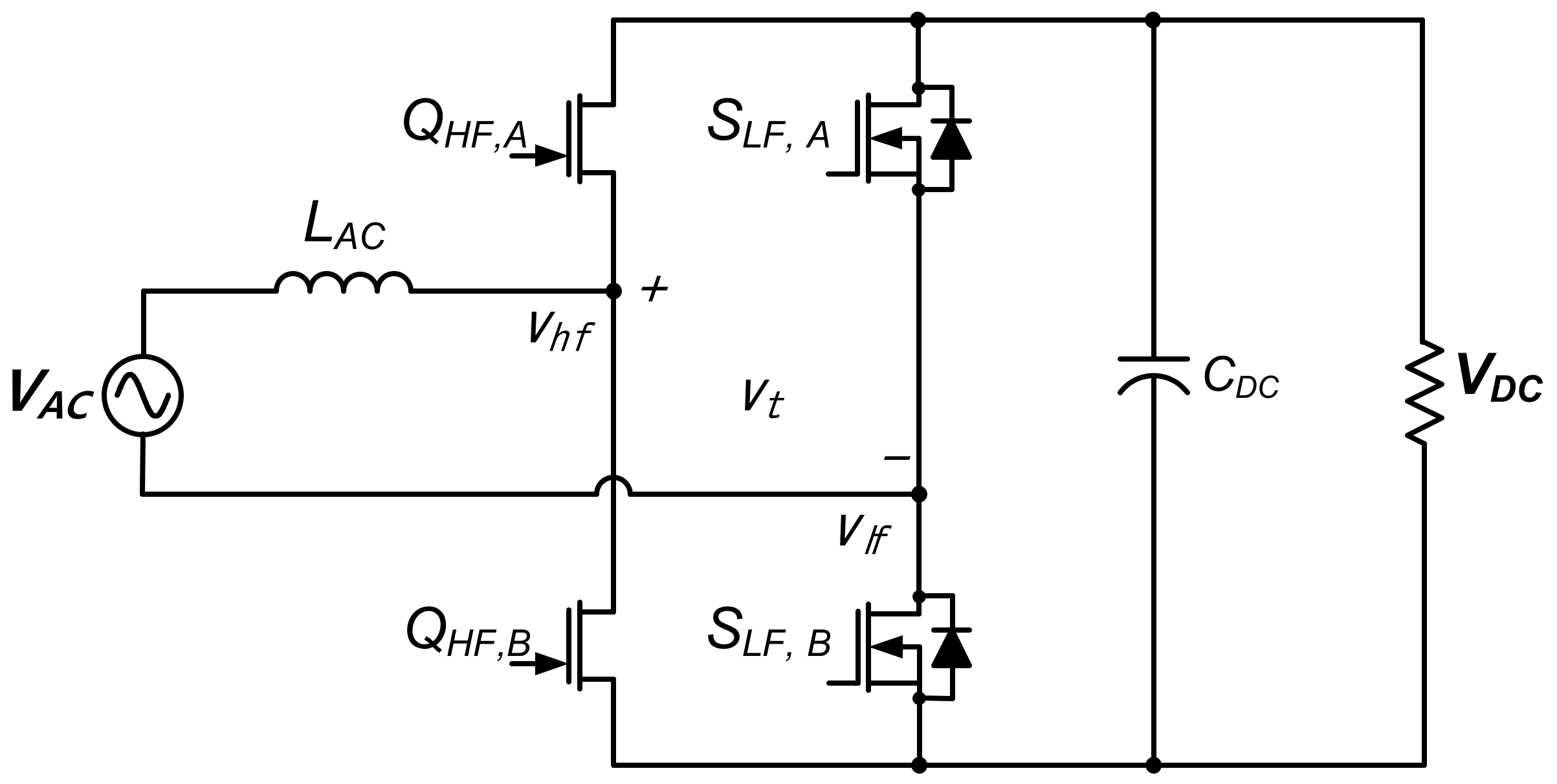
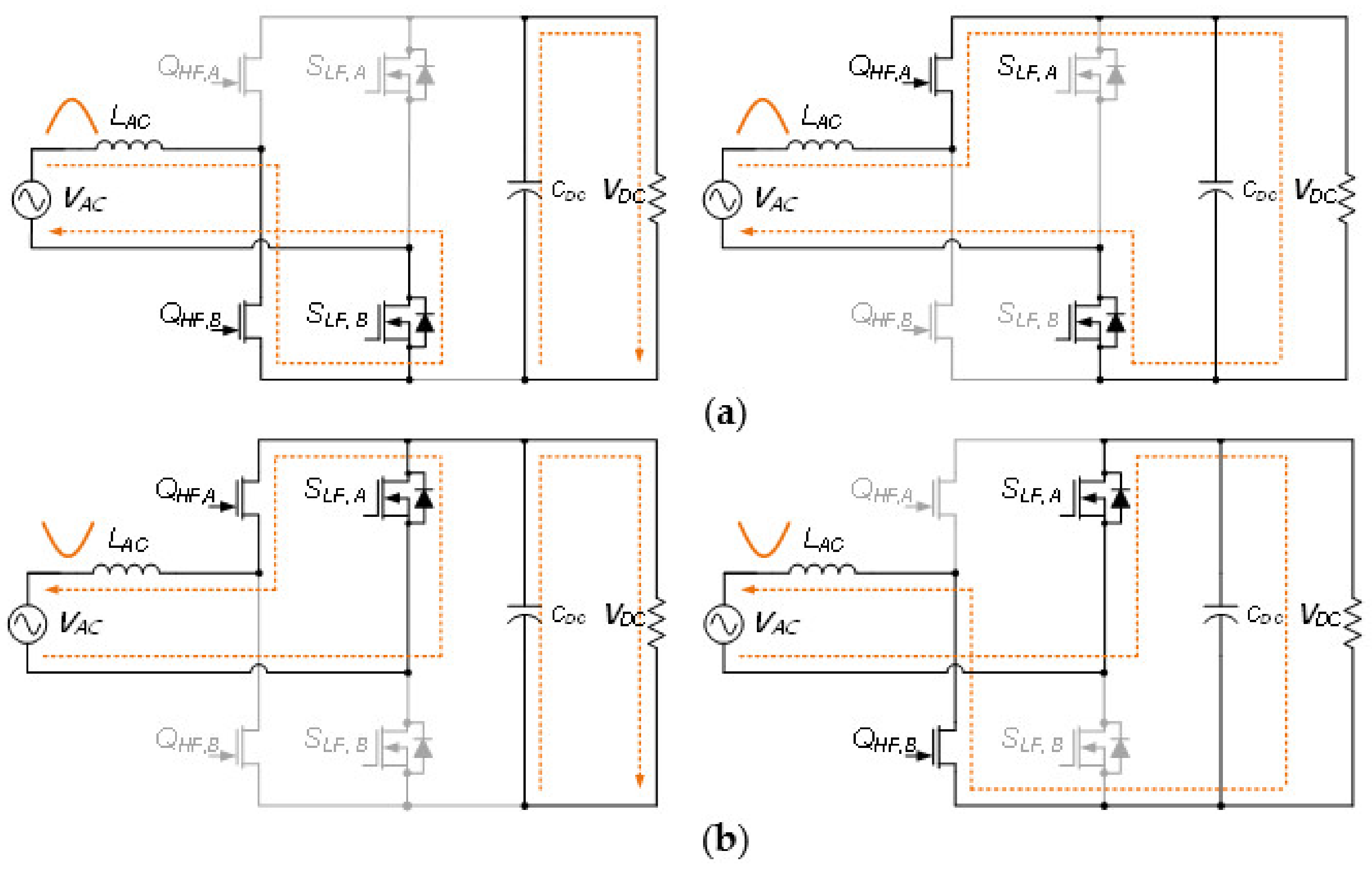


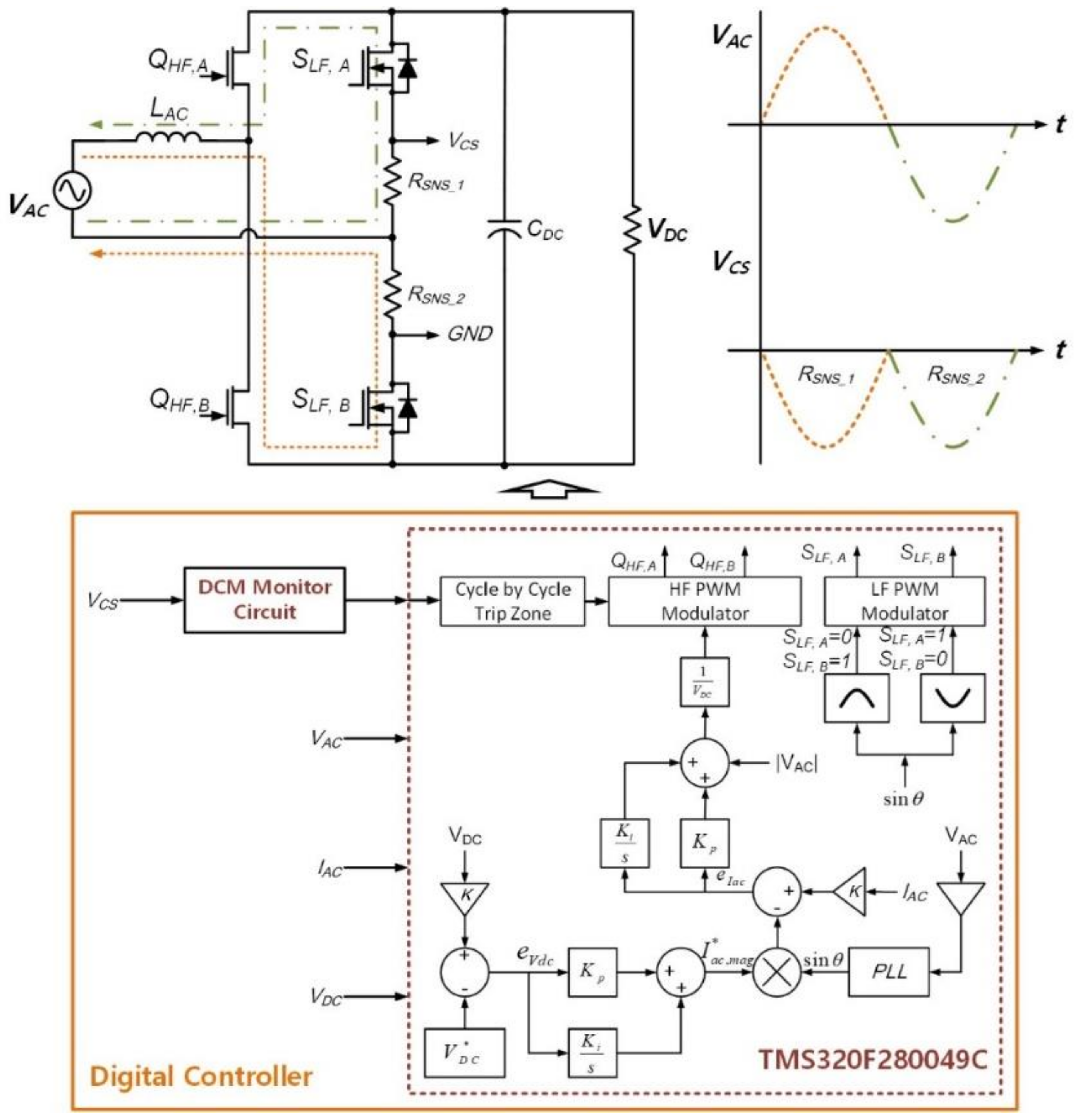
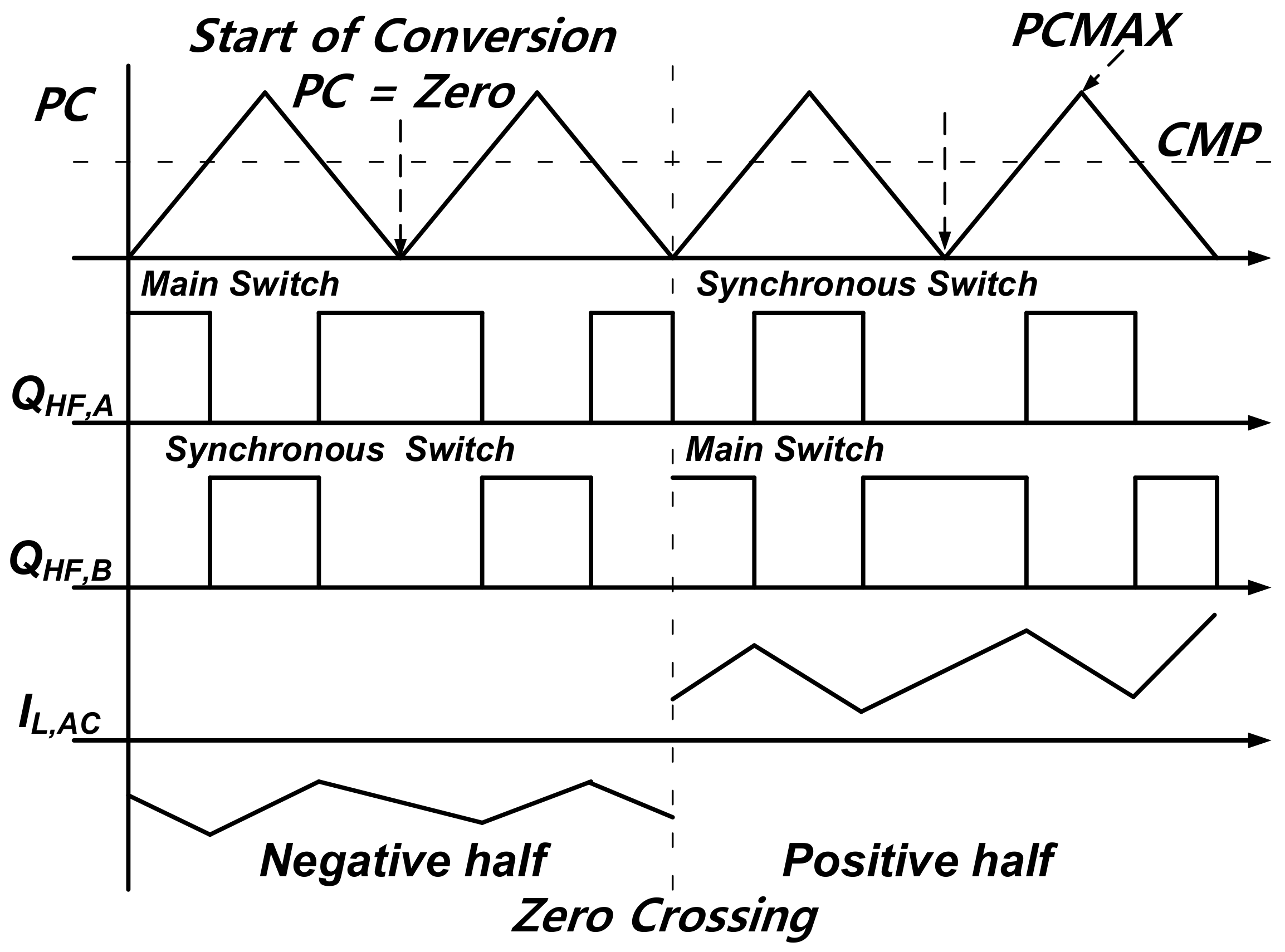

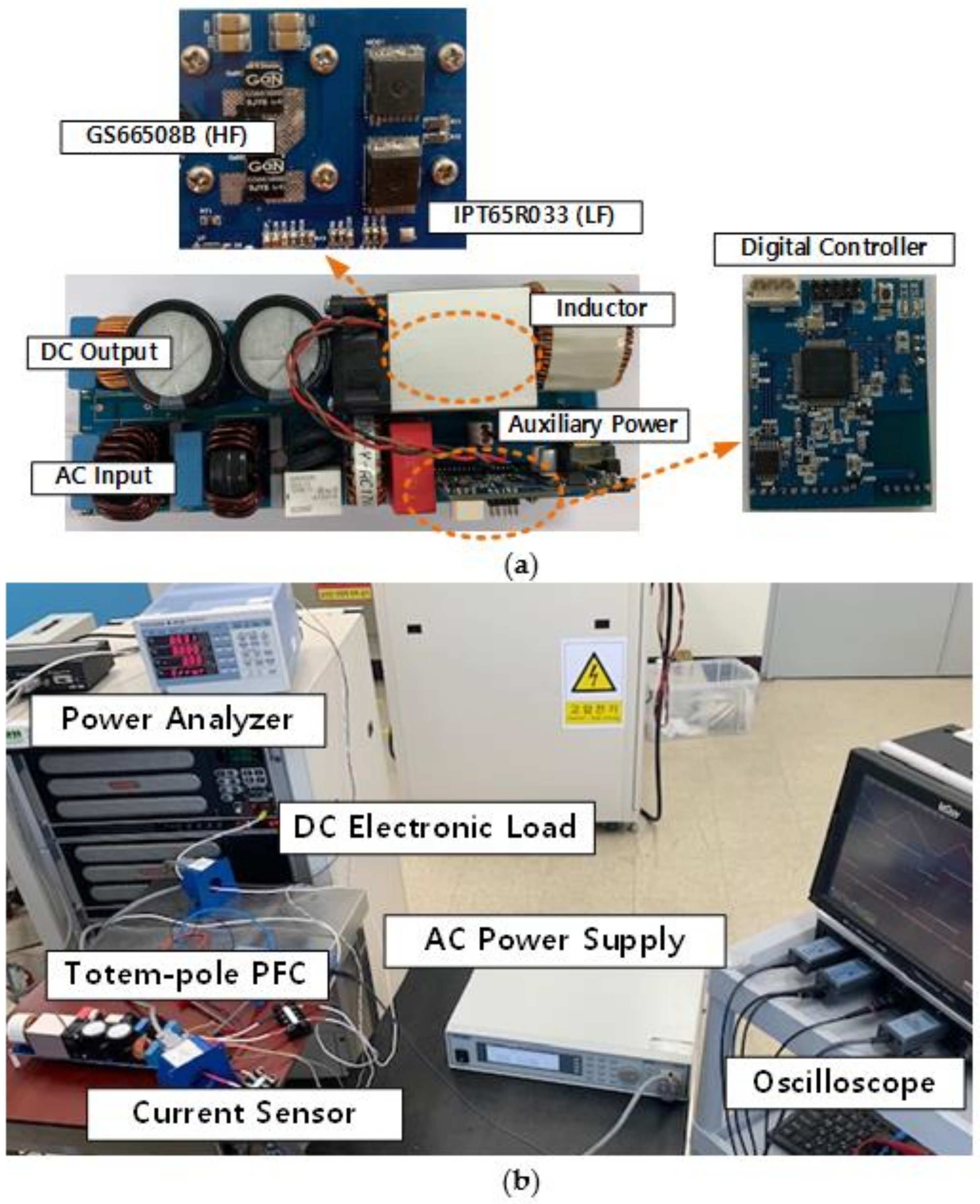
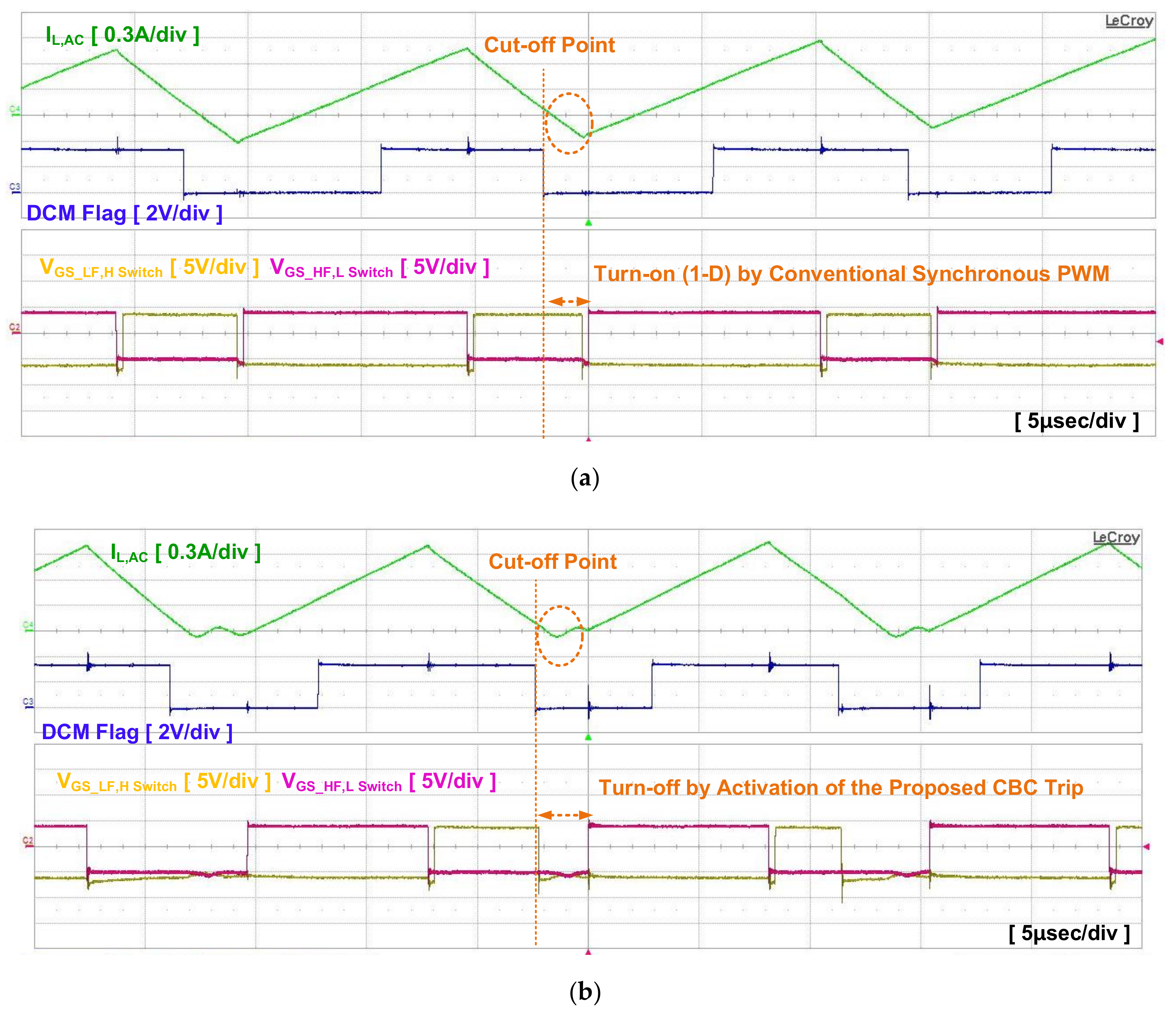
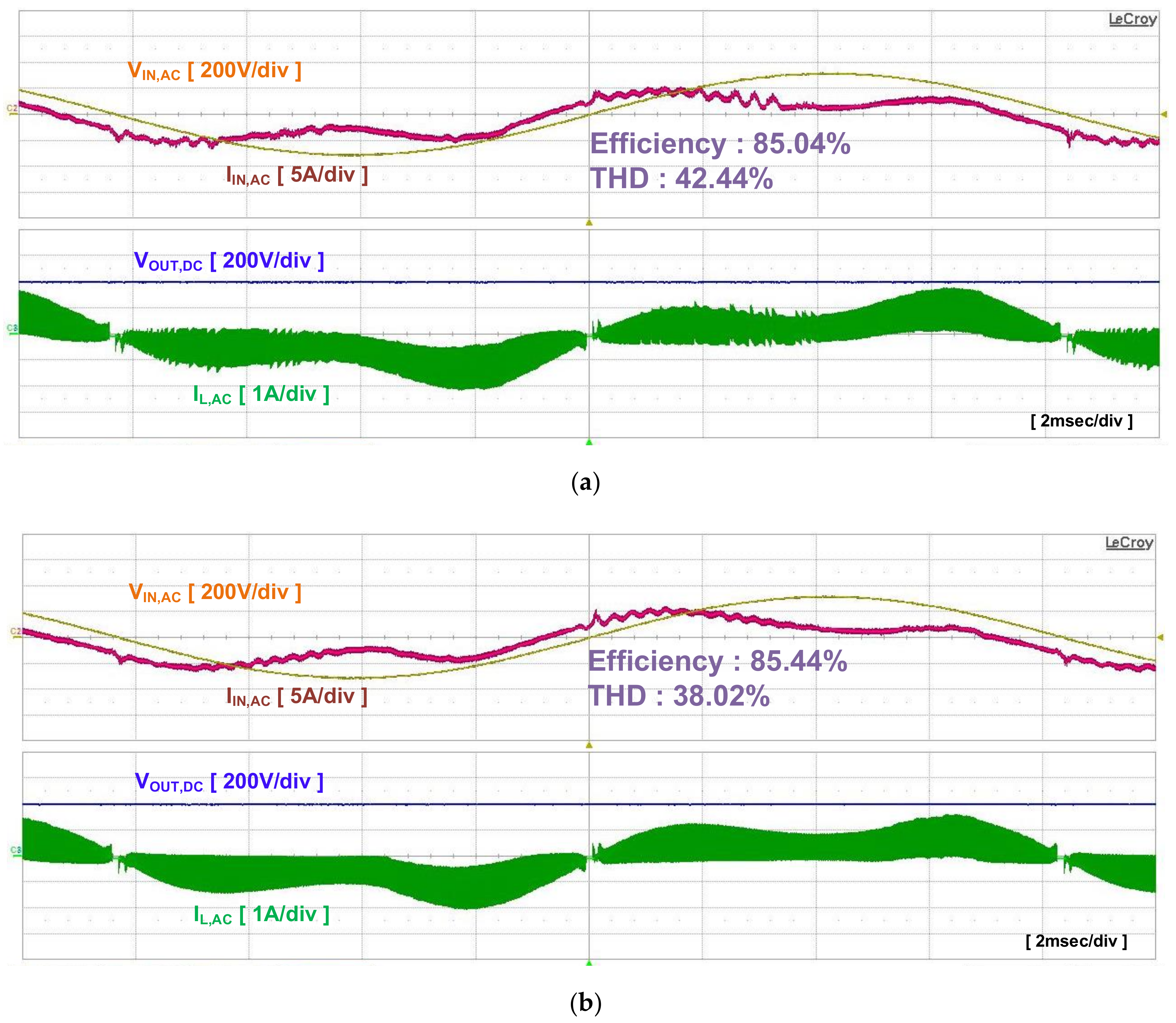
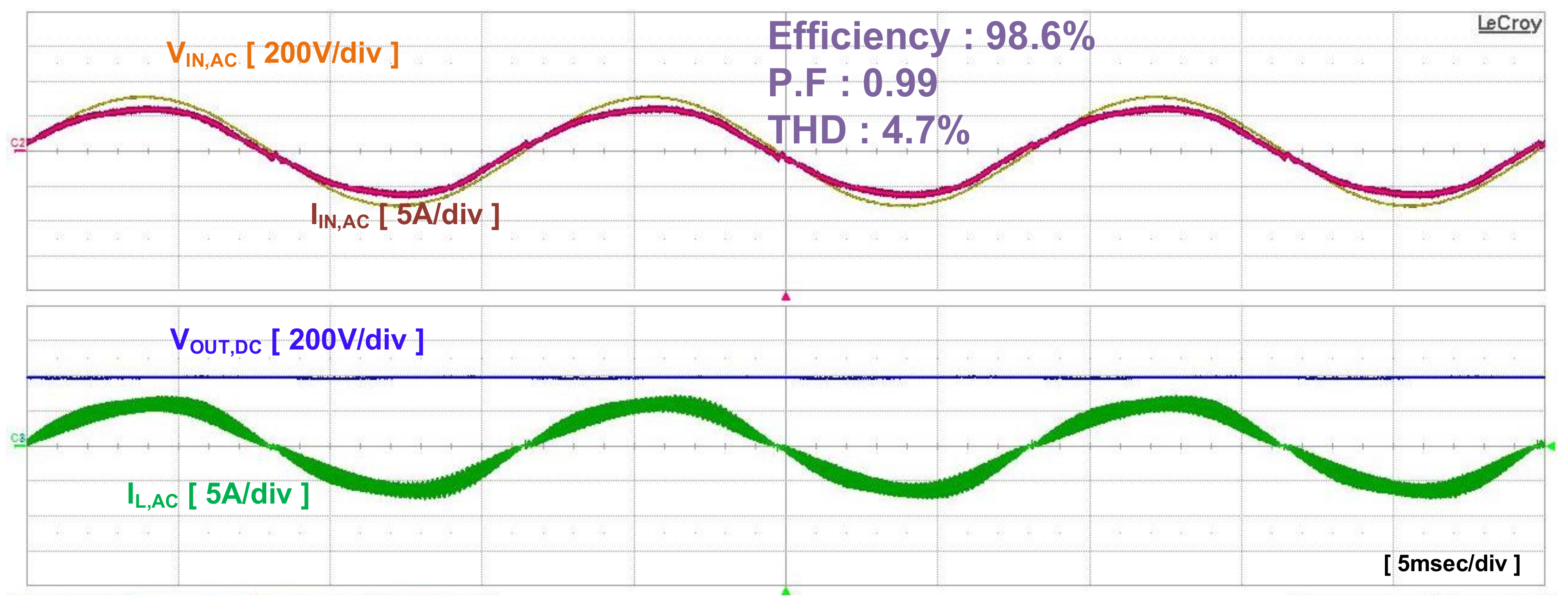
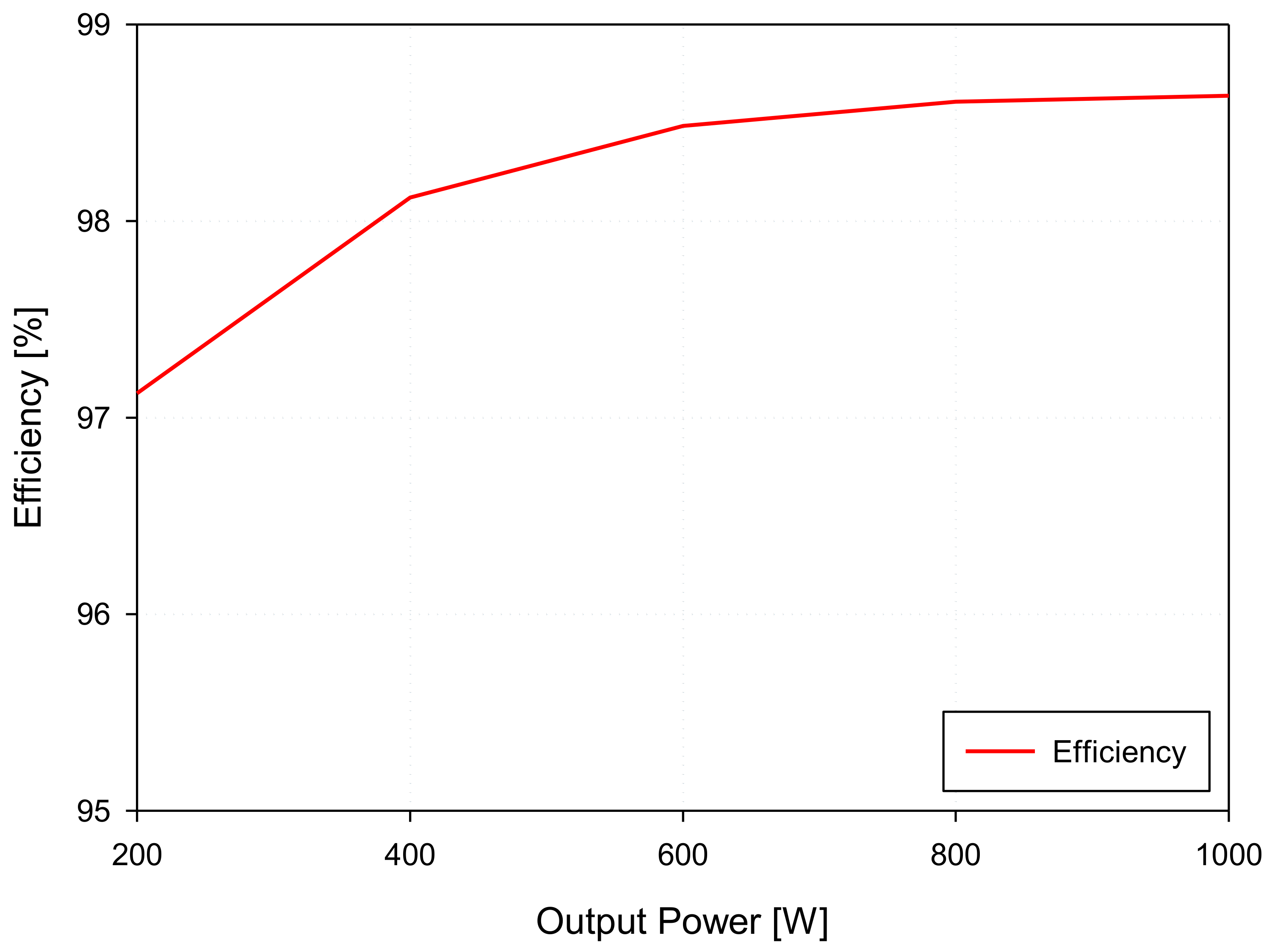
| AC Voltage | Events | QHF,A | QHF,B | SLF,A | SLF,B |
|---|---|---|---|---|---|
| Negative half | PC = CMP @ Up | Clear to 0 | Set to 1 | ||
| PC = CMP @ Down | Set to 1 | Clear to 0 | |||
| SINE(θ) < 0 | Set to 1 | Clear to 0 | |||
| Positive half | PC = CMP @ Up | Set to 1 | Clear to 0 | ||
| PC = CMP @ Down | Clear to 0 | Set to 1 | |||
| SINE(θ) > 0 | Clear to 0 | Set to 1 |
| Parameter | Value | Unit |
|---|---|---|
| Input Voltage | 220 | VAC@60Hz |
| Output Voltage | 390 | VDC |
| Output Power | 1 | kHz |
| DC Capacitance | 470 × 2 | μF |
| Inductance | 650 | μF |
| Switching Frequency | 65 | kHz |
| Conventional Method | Proposed Method | Comparison Value | |
|---|---|---|---|
| Efficiency | 85.04% | 85.44% | 0.4% |
| THD | 42.44% | 38.02% | 4.42% |
Publisher’s Note: MDPI stays neutral with regard to jurisdictional claims in published maps and institutional affiliations. |
© 2020 by the authors. Licensee MDPI, Basel, Switzerland. This article is an open access article distributed under the terms and conditions of the Creative Commons Attribution (CC BY) license (http://creativecommons.org/licenses/by/4.0/).
Share and Cite
Kwak, B.; Kim, J. Digital Implementation Method for Synchronous PWM Control of GaN Transistor at Zero-Crossing of Totem-Pole PFC in Energy Storage Applications. Electronics 2021, 10, 30. https://doi.org/10.3390/electronics10010030
Kwak B, Kim J. Digital Implementation Method for Synchronous PWM Control of GaN Transistor at Zero-Crossing of Totem-Pole PFC in Energy Storage Applications. Electronics. 2021; 10(1):30. https://doi.org/10.3390/electronics10010030
Chicago/Turabian StyleKwak, Bongwoo, and Jonghoon Kim. 2021. "Digital Implementation Method for Synchronous PWM Control of GaN Transistor at Zero-Crossing of Totem-Pole PFC in Energy Storage Applications" Electronics 10, no. 1: 30. https://doi.org/10.3390/electronics10010030
APA StyleKwak, B., & Kim, J. (2021). Digital Implementation Method for Synchronous PWM Control of GaN Transistor at Zero-Crossing of Totem-Pole PFC in Energy Storage Applications. Electronics, 10(1), 30. https://doi.org/10.3390/electronics10010030






